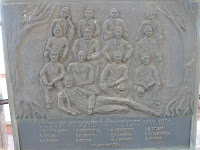(Magyar összefoglaló a végén)
 |
| Dubbo main street |
Today we spent most of the day in the Zoo, a vast open-air park where most animals have much more space than in a typical urban zoo. Sometimes the space was so big that it was hard to find and see the animals. The park is very pretty, especially at this time of the year, with lots of wild flowers. We saw most of the animals on display, mostly from Africa, various antelopes, zebras, giraffe, elephant, lion, ostrich, camel, rhino, meerkat, but some from other continents, a bit haphazardly, bison, Sumatran tiger, and some locals, emu, koala, wallaby, wombat.
Still, we had the feeling that there were fewer animals than we had remembered, and quite a few display areas were empty; not sure why. It was a sunny but not to warm day, so we had a very enjoyable time out there, it is definitely worth a visit (once in every 20 years...)
 |
| Dubbo Zoo |
 |
| Blue Mountains - almost home!... |
 |
| Welcome, Sydney style... |
Here are some summary statistics of our round trip:
Total distance travelled: 29,265 km (including more than 1,000 on dirt/gravel)
Total fuel consumed: 3,876.66 l
Average fuel consumption: 13.24 l/100 km
While the segments of our itinerary can be seen on Google Maps, here is an overview of the whole trip:
Looking at that map it is amazing how much of Australia we have NOT seen, despite the distance we covered. So there will be still things to see next time!
Now we will have to get used to living in a house again, and think about the next trip!...
Our itinerary can be seen at the following Google Map:
http://g.co/maps/wcwv8
(Note that to see the route after Bowen, you need to move down to the bottom of the left panel, and select the following pages!)
Múlt hétfon reggel indultunk tovább Lightning Ridge-bol, és déltájban már Dubbo-ban voltunk, ami már csak kb 400 km-re van Sydney-tol, egy nagy mezogazdasági és szerviz-központ. Legnagyobb turista vonzerejét egy nagy állatkert adja. Egyszer már jártunk itt a gyerekekkel együtt, 19 évvel ezelott egy hosszú hétvégi látogatásra. Akkor is nagyon tetszett a frissen rehabilitált, jól szervezett városközpontja. Hétfon délután most is végigsétáltunk a központon és környékén, megnéztük a "muemléki értéku" épületeket is de nem voltak túl érdekesek (nekem legalábbis).
Kedden a nap nagyrészét az állatkertben töltöttük. Itt az állatok nagy tágas parkszeru, de persze jól elkerített, kifutó-karámokban vannak, valamivel talán több szabadságuk van mint egy átlagos városi állatkertben. Foleg afrikai állatokat tartanak, rinocérosz, elefánt, oroszlán, zsiráf, teve, strucc, többféle antilop, néhány majom-fajta, de van egy pár máshonnan is, bölény, szumátrai tigris, no és persze a hazaiak, kenguru, emu, koala, stb. A parkban autóval lehet körbemenni itt-ott megállva nézelodni, sétálni, lehet piknikelni is több helyen. A növényzet is nagyon szép, különösen ilyenkor tavasszal, rengeteg szines vadvirág köröskörül. Igazán kellemes nap volt, bár az volt az érzésünk, hogy kevesebb állat van mint régen, elég sok karám üresen állt.
Szerda reggel aztán elindultunk hazafelé, és délutánra már itthon is voltunk. Eredetileg meg akartunk állni mégegyszer, de aztán már nagyon éreztük az otthon vonzását. Jó nagy forgalom volt az úton, a csúcsforgalom kezdetén értünk Sydney-be, ehhez most majd megint hozzá kell szokni, miután az "outback"-ben alig találkoztunk autóval.
Hát így ért véget az utunk. 179 napig utaztunk, 29,265 km-t tettünk meg, 3,876 liter üzemanyaggal, ami 13.2 l/100 km átlagos fogyasztást jelent, amivel igazán meg lehetünk elégedve.
Itthon szerencsére mindent rendben találtunk a házban és körülötte, persze a benti növények nagyrészt elpusztultak, de erre számítottunk.
Azóta egyfolytában pakolunk, rendezkedünk, takarítunk, és ez még el fog tartani egy jó ideig mire nagyjából renbejövünk.
Az útvonalunk a következo Google Map-on látható:
http://g.co/maps/wcwv8
(A Bowen utáni szakaszokhoz le kell menni a baloldali panel aljára, és a következo oldalakra kattintani!!)










































